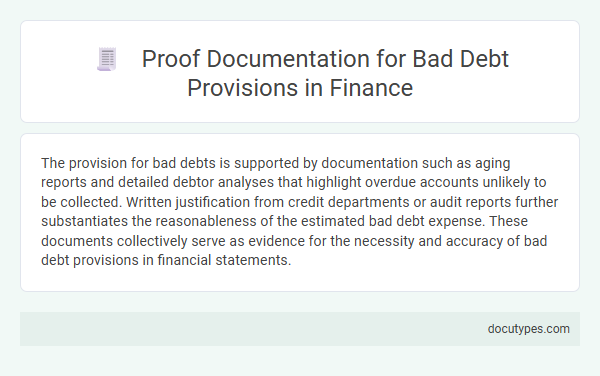The provision for bad debts is supported by documentation such as aging reports and detailed debtor analyses that highlight overdue accounts unlikely to be collected. Written justification from credit departments or audit reports further substantiates the reasonableness of the estimated bad debt expense. These documents collectively serve as evidence for the necessity and accuracy of bad debt provisions in financial statements.
Understanding Bad Debt Provisions in Financial Reporting
In financial reporting, the allowance for doubtful accounts or bad debt provision is documented through journal entries and supporting schedules. These documents provide evidence of estimated uncollectible amounts based on historical data and current credit evaluations.
The key proof for bad debt provisions lies in the detailed aging reports and analysis of receivables, which justify the estimated write-offs. Auditors review these financial statements and notes to confirm the accuracy and compliance of the bad debt provision with accounting standards such as GAAP or IFRS.
Key Documentation Requirements for Bad Debt Provisions
The primary document serving as proof for bad debt provisions is the accounts receivable aging report, which details outstanding customer balances and their overdue status. Supporting evidence includes correspondence with debtors, such as demand letters or collection notices, demonstrating efforts to recover the debt. Financial statements and audit reports further validate the reasonableness of the bad debt provision in compliance with accounting standards.
Essential Evidence for Recognizing Bad Debts
Identifying the correct document is crucial for establishing bad debt provisions in financial records. Proper documentation ensures accuracy and compliance in recognizing uncollectible accounts.
- Accounts Receivable Aging Report - This report categorizes outstanding invoices by their due dates and helps identify debts likely to become uncollectible.
- Credit Correspondence - Communications such as demand letters or collection notices provide evidence of efforts made to recover debts.
- Financial Statements - Notes in financial statements disclose the methodology and justification for bad debt provisions.
You must maintain these documents to support your bad debt recognition and ensure proper financial reporting.
Audit Trails Supporting Bad Debt Allowances
The primary document serving as proof for bad debt provisions is the audit trail that details the history and justification of these allowances. Your company's financial records must include transparent and verifiable evidence to support any bad debt write-offs.
Audit trails provide a clear record of the decision-making process and ensure compliance with accounting standards related to bad debt. These documents are essential during financial audits to verify the legitimacy of provisions recorded.
- Accounts Receivable Aging Report - Displays overdue customer balances used to estimate doubtful debts.
- Credit Memos and Write-off Authorizations - Formal approvals confirming the need for bad debt provisions.
- Correspondence with Debtors - Records communication attempts proving efforts to recover outstanding debts.
Role of Debtor Communication in Proof Documentation
The primary document serving as proof for bad debt provisions is the written communication from the debtor, such as overdue invoices, demand letters, or email correspondence confirming non-payment. These documents demonstrate the creditor's efforts to recover the debt, which is essential for validating the provision.
Debtor communication plays a crucial role in establishing evidence of financial distress or unwillingness to pay, supporting the justification for bad debt recognition. Detailed records of payment reminders and responses help auditors and regulators assess the legitimacy of the provision. Consistent documentation also safeguards companies during financial reporting and tax examinations by providing transparent proof of collection attempts.
Assessing Recoverability: Analytical and Documentary Support
| Document Type | Purpose | Key Elements | Role in Assessing Recoverability |
|---|---|---|---|
| Account Aging Report | Identifies overdue receivables | Invoice dates, outstanding balances, aging buckets | Helps quantify exposure to doubtful debts and timing of defaults |
| Correspondence with Debtor | Records communication about payment status | Emails, letters, payment promises, disputes | Provides evidence of collection efforts and debtor's position |
| Credit Risk Assessment Report | Evaluates debtor's financial health | Financial ratios, credit scores, payment history | Supports estimation of recoverability likelihood |
| Legal Notices or Demand Letters | Documents formal collection attempts | Dates, content of notices, response or lack thereof | Demonstrates active steps towards debt recovery |
| Internal Provision Calculation Worksheet | Details basis for bad debt provision | Outstanding amounts, provision percentage, rationale | Serves as primary proof for accounting entries related to bad debt |
Regulatory Guidelines on Bad Debt Documentation
Which document serves as proof for bad debt provisions in financial reporting? Regulatory guidelines require that specific documentation, such as detailed debtor correspondence and outstanding account statements, supports the recognition of bad debt provisions. Your compliance with these guidelines ensures accurate financial statements and audit readiness.
Common Pitfalls in Documenting Bad Debt Provisions
The primary document serving as proof for bad debt provisions is the aging report, which details overdue accounts and supports the estimation of doubtful debts. Accurate documentation is crucial for validating the financial statement adjustments related to bad debts.
Common pitfalls in documenting bad debt provisions include incomplete or outdated aging reports and lack of clear justification for the provision amounts. You must ensure consistent review and proper authorization to avoid audit challenges and financial inaccuracies.
Best Practices for Preparing Proof of Bad Debts
The document that serves as proof for bad debt provisions is typically the aged accounts receivable report combined with detailed correspondence evidence showing collection efforts. Accurate documentation includes invoices, customer communication, and records of written-off accounts to validate the inability to collect. Ensuring these records are thorough and up-to-date is essential for compliance and audit readiness, helping you support your bad debt claims effectively.
Which Document Serves as Proof for Bad Debt Provisions? Infographic

